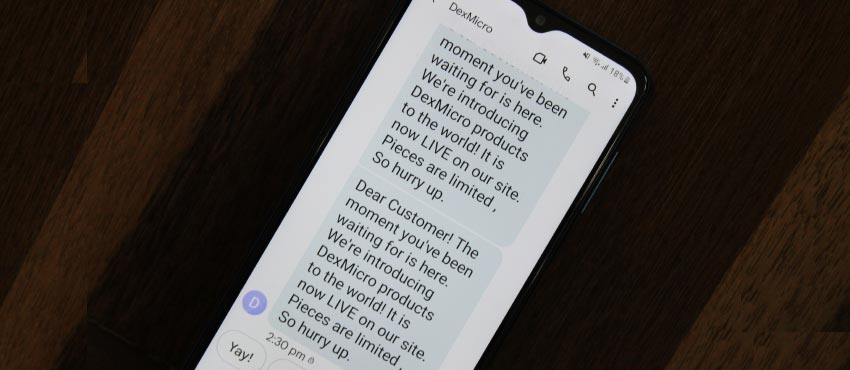Track the Delivery Status of Bulk SMS Messages
Bulk SMS software typically provides features that allow you to track the delivery status of your SMS messages. Here's an overview of how you can track the delivery status using bulk SMS software:

-
Delivery Reports:
Bulk SMS software generates delivery reports that provide information about the status of each message you send. These reports indicate whether a message has been successfully delivered, failed, or is pending delivery. Delivery reports may include details such as the recipient's phone number, date and time of delivery, delivery status code, and any error messages received.
-
Real-Time Monitoring:
Some bulk SMS software provides real-time monitoring of message delivery. This allows you to track the progress of your SMS campaigns as messages are being sent. You can view the status of each message in real-time, enabling you to identify any delivery issues promptly.
-
Bulk Message Status
Overview:
The software may offer a consolidated overview of the delivery status for all the messages in a particular campaign or within a specific timeframe. This overview provides a summary of the number of messages sent, delivered, failed, or pending. It helps you gauge the overall performance and success of your SMS campaign.
-
Filtering and Sorting
Options:
Bulk SMS software often includes filtering and sorting options to help you navigate and analyze delivery reports effectively. You can filter messages based on criteria such as delivery status, date range, recipient phone numbers, or message content. This allows you to focus on specific subsets of messages and gain insights into their delivery status.
-
Error Handling and
Reprocessing:
In cases where messages have failed to deliver, bulk SMS software may provide options for error handling and reprocessing. You can review the error messages associated with failed messages and take appropriate action, such as updating incorrect phone numbers, addressing issues with message content, or resending failed messages.
-
Exporting and Reporting:
Many bulk SMS software solutions allow you to export delivery reports and generate detailed reports for further analysis. You can export the delivery reports to formats such as CSV or Excel, enabling you to analyze the data, track trends, and generate performance reports. These reports can provide valuable insights into the success of your SMS campaigns and help you optimize your messaging strategies.
Note: It's important to note that the specific tracking and reporting features may vary depending on the bulk SMS software you choose. Some software providers may offer advanced tracking capabilities, including detailed analytics, open rates, click-through rates, and conversion tracking. It's advisable to evaluate the reporting features of the software and choose a solution that provides the level of tracking and reporting that aligns with your specific needs.
Conclusion: By leveraging the delivery tracking features of bulk SMS software, you can monitor the status of your SMS messages, identify any delivery issues, and make necessary adjustments to ensure the success of your SMS campaigns.
Limit to the Number of SMS Messages can Send in a Day or Month
There may be limits to the number of SMS messages you can send in a day or month using bulk SMS software. These limits can vary depending on several factors, including the service provider, the software package you have chosen, regulatory restrictions, and the agreement you have with your service provider. Here's a detailed explanation:

-
Service Provider Limits:
Your bulk SMS service provider may impose limits on the number of messages you can send within a specific timeframe. These limits are often in place to ensure fair usage, maintain network stability, and prevent misuse or spamming. Service providers may have different tiers or packages with varying message sending limits. For example, a provider may have a limit of 10,000 messages per day or 100,000 messages per month for a particular subscription plan. It's important to review the terms and conditions of your service provider to understand their specific limits.
-
Software Package
Limitations:
The bulk SMS software package you have chosen may also have predefined limits on the number of messages you can send within a given timeframe. These limits are typically set by the software provider based on their infrastructure, pricing plans, and service agreements. For instance, a software package may allow you to send up to 50,000 messages per month or 2,000 messages per day. It's essential to review the specifications and limitations of your chosen software to understand its capacity.
-
Regulatory Restrictions:
Regulatory bodies in different countries or regions may impose limitations on the volume of SMS messages you can send within a specific timeframe. These restrictions are in place to prevent spamming, protect consumer privacy, and maintain a controlled SMS environment. Regulatory guidelines may define limits on message volume per day, per month, or per recipient. It's crucial to familiarize yourself with the regulations applicable to your location and industry to ensure compliance with these limitations.
-
Agreements and Custom
Arrangements:
In some cases, you may be able to negotiate higher sending limits or custom arrangements with your bulk SMS service provider. If you have specific messaging requirements or need to send a significantly higher volume of messages, you can discuss this with your provider and explore options for increased limits. Custom arrangements may involve additional costs or specific terms, so it's important to have these discussions with your provider.
Note: It's worth noting that exceeding the prescribed limits set by your service provider or regulatory bodies can result in message delivery issues, account suspension, or violation of legal requirements. It's essential to understand and adhere to the limits imposed to ensure the smooth and compliant operation of your bulk SMS campaigns.
Conclusion: To determine the specific limits applicable to your situation, it's recommended to consult with your bulk SMS service provider and review their documentation, terms of service, and any regulatory guidelines that may apply.
Date: 10/08/2023